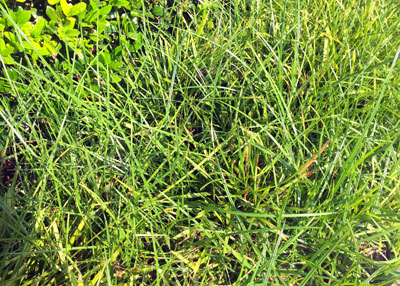Question of the Week 3: August 10, 2017
“Neil, my beds are overrun with nutsedge. What can I do to get rid of it?”
I actually saw this particular bed personally, and the outbreak of nutsedge was so bad that it almost had to have come in with the planting mix. There is no way it could have spread so far and wide before it would have been intercepted.

Photo: Purple nutsedge must have come with the soil mix at the time this bed was prepared for the population to be this uniform and this dense. This may demand total soil replacement.
However, true to my history, I’m going to give my stock answer on nutsedge control. I’ll call it “Plan A.” Then I’ll give a far more extreme option that probably needs to be employed in this isolated case. That will be “Plan B.”
Start with the ID…
You need to be sure you’re dealing with true nutsedge, sometimes called “nutgrass” because of its grass-like appearance. If you roll the stem of any sedge between your index finger and thumb it will always be triangular. Grass stems (bermuda, St. Augustine, crabgrass, grassburs, corn, bamboo, etc.) are always round.
Nutsedge plants produce a small number of leaves per plant, usually just six or eight. They are very glossy and somewhat attractive. The plants also produce a network of bulbous roots that look like tiny coconuts. They daisy-chain through flowerbeds, making them almost impossible to eliminate by digging or pulling. When they break free they form new plants and start new colonies.
Plan A: The option for almost all cases of nutsedge in lawns and beds: you try to kill it…
• Image. About 25 years ago a new product called Image was introduced into the market for the control of purple nutsedge (the most common type). Image is applied to a specified area of lawn or bed space, then it is watered into the soil with a thorough soaking. The first label I read didn’t advise me of how much water to use, so I called the manufacturer. The sales rep explained the obvious: It doesn’t matter, as long as you use enough to cover the area specified, because you’re going to be applying all that extra water immediately afterwards anyway. That’s because Image works differently from most other herbicides. It must be taken into the weed through the roots.
It takes two treatments of what I refer to as “the original Image” to get the job done. They must be made 30 days apart, and both of them must be made during the seasons of active growth (mid-May through mid-September). What that means is that you must make your first treatment immediately now if you expect to get the second one down in time by mid-September.
• Sedgehammer. A second product, first named Manage and now called Sedgehammer, came into the marketplace a few years after Image. Sedgehammer has been used a bit more in the commercial industry, and I must admit to not having used it personally. It requires only one treatment during the season of active growth. Like Image, it is not a fast-acting herbicide, so be patient. If it works, you will see a gradual reduction in the population of the nutsedge, again, just as you do with Image. You eventually realize that you have far fewer nutsedge plants than you did at the outset.
Plan B: The option for the most extreme outbreaks like the one in my photo.
There are times when I’m not sure Image or Sedgehammer will be able to beat back the nutsedge, and it’s at those overwhelming times that I personally throw up my arms and turn to total replacement of the soil instead.
In the example I showed in my photo I would probably remove the top 14 inches of soil in that bed, even if it included sacrificing a few shrubs or all of my flowers for that current season. If it happened to be a perennial bed, I’d carefully dig them and wash their roots to be sure there were no nutsedge plants intertwined. Early October is probably the best time to do this for the biggest number of perennial plants. Essentially I’d be digging a trench, carefully removing every nutlet and plant – every vestige of nutsedge that ever grew there.
I would bring in entirely new landscape mix, and if I bought it, I would get an agreement in writing that it would be free of nutsedge before it was ever delivered and dumped. This is one of the world’s most difficult weeds to eliminate, and when it shows up in your landscape or garden (as it almost always seems to), you need to address it immediately. Those who wait will almost always suffer grave consequences.
